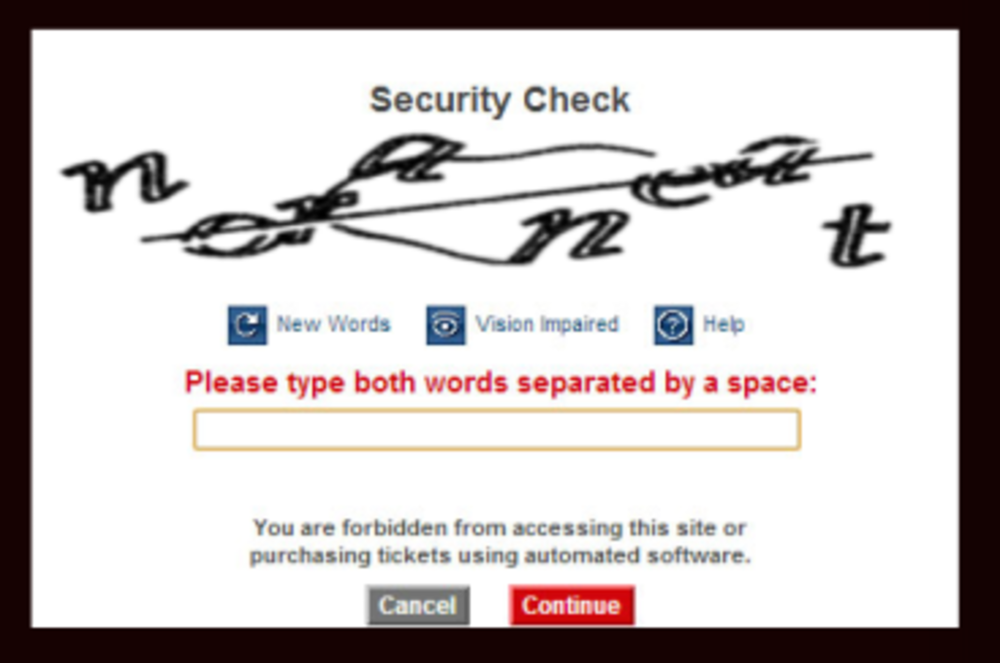The Objective: Show me a man who enjoys filling out a CAPTCHA form and I will show you a liar.
CAPTCHA, an acronym for the mouthful, “Completely Automated Public Turing test to tell Computers and Humans Apart,” is used by websites to ensure that they’re dealing with humans and not bots. But this 13-year-old technology—in use as a security measure on millions of websites—hasn’t changed with the times, often presenting befuddled Web surfers with something that looks like a mix between a Rorschach test and a wet noodle.
When websites first started using CAPTCHA in 2000, all Web visitors had to do was type in a legible series of letters to prove their humanity. But as hackers have become more sophisticated, CAPTCHA has had to become more complicated. The only way to make a website more secure using CAPTCHA is to make it harder for the bots, which in turns also makes it more difficult for humans.
But Are You a Human, a Detroit start up that specializes in game-based verification systems, is turning the traditional CAPTCHA on its ear by transforming what was once an irritation into a branded game that has the added benefit of increasing brand favorability.
“There’s a visceral reaction to CAPTCHA across the board; I’ve talked to hundreds of people about it and I’ve never heard anyone say, ‘It’s OK, it’s not that bad,” says the company’s cofounder Reid Tatoris. “What I love is the fact that CAPTCHA is universally hated, but still universally used.”
Which is why The Ford Motor Company implemented an Are You Human ad verification—known as a PlayThru—for the relaunch of its highly social “Fiesta Movement” campaign to support the 2014 Ford Fiesta. With a target audience of seriously digitally savvy 18- to 34-year-olds, the last thing Ford wanted to do was present them with a barrier to engagement.
“We continue to seek out unique ways to reach consumers, and find success in cutting-edge interactive advertising that delivers both a deeper brand engagement and a positive user experience,” says Andrea Zuehlk, For’s digital marketing manager.
The Solution: In a PlayThru, rather than being presented with a series of distorted letters, users are asked to play a simple interactive game. In one Ford example, users are asked to drag a Ford Fiesta across a map of the U.S. to Chicago. In another, users have to “pack the 2014 Fiesta for the music festival” by dragging and dropping a cartoon mic and guitar into the trunk of the car. Having completed the easy task, users can then click through to the Fiesta Movement hub page. (Check out a demo here.)
“With a lot of advertising, people generally get trained to ignore it more and more, and one approach is to just show them more ads more often and get in their faces,” Tatoris says. “Ford really wanted to do something people could have a positive experience with; in other words, to take an experience people hate and make it into something people can actually enjoy.”
The Results: Users who engage with PlayThru units experience a 300% increase in brand recall, as well as 35% higher brand favorability versus with standard rich media.
In the case of Ford, the brand’s PlayThrus—which started in August and will run through the end of the year—garnered a 97% completion rate and an average click-through rate of 8.76%. According to DoubleClick, the average click-through rate on display ads is 0.1%.
The Takeaway: There’s no reason not to turn lemons—the need to thwart bots—into delicious engagement lemonade that’s refreshing for the consumer and profitable for the brand.
“We think this type of interactive ad unit gives us a true understanding of where the eyeballs are and where the interactions are,” says Ford’s Zuehlk. “And [it] eliminates waste, which is big for us.”






